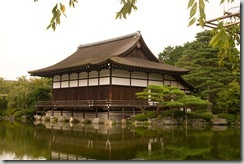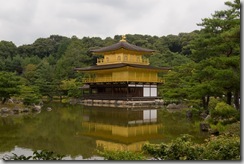A mixture of posts on computers, photography, cats and holidays. In other words, all the things that interest me most.
Thursday, November 06, 2008
New blog
Tuesday, October 09, 2007
Day #5 - Lost in Translation
With our hosts having to go to work for the day, we were left to our own devices, which mainly consisted of a guided bus tour of Kyoto. Due to the toilets at the bus station being located almost half a block away, we missed our scheduled bus by about a minute (curse that Japanese punctuality!), so with a cry of, "Follow that bus!", we grabbed a taxi and attempted to get to the first stop on the itinerary ahead of the bus. We were rather mindful of horror stories of how much Tokyo cabs cost, but fortunately our man came through, and we pulled up at the first shrine just as our fellow tourists were disembarking.
One thing that became immediately obvious was that we were the only foreigners on the tour, and also that no-one else spoke Japanese, the guide included. In some cases, this even included the various guide pamphlets, so there are some places that we have been to that we have absolutely no idea what their significance is.
 Heian-jingu was the first stop along the route, built in 1895 to commemorate the 1100th anniversary of the founding of the Kyoto. The buildings are reduced-size replicas of the Heian-period Imperial palace; the garden is also very photogenic, so we had a slightly-hurried wander around, not wanting to miss the bus onwards.
Heian-jingu was the first stop along the route, built in 1895 to commemorate the 1100th anniversary of the founding of the Kyoto. The buildings are reduced-size replicas of the Heian-period Imperial palace; the garden is also very photogenic, so we had a slightly-hurried wander around, not wanting to miss the bus onwards.
Our next stop was Togetsukyo Bridge. Unfortunately, the language barrier meant that we had no idea what we were looking at, or why we were looking at it! This also meant that I didn't take any photos of it, since at this time of year it's just a bridge. Later on we Googled it to work out what we missed - apparently it's good for viewing the cherry blossom in spring and the autumn leaves in, um, autumn - shame we missed both! On the plus side, we did get to eat unagi, although again we had no idea what it was at the time.
 After lunch, we headed for probably the most visually spectacular shrine, at Kinkaku-ji, the Golden Temple. This is a 20th century reconstruction of the the 14th century original (a rather obsessed monk burned it down in 1950), and the gold leaf now covers the first floor as well as the second. The gardens were equally impressive, with a few more signs of trees turning colour with the autumn.
After lunch, we headed for probably the most visually spectacular shrine, at Kinkaku-ji, the Golden Temple. This is a 20th century reconstruction of the the 14th century original (a rather obsessed monk burned it down in 1950), and the gold leaf now covers the first floor as well as the second. The gardens were equally impressive, with a few more signs of trees turning colour with the autumn.
 Kiyomizu-dera required a bit more hard work to reach, climbing up the hillside along a street lined with touristy-type shops. It was obviously a favourite destination for school trips, as there were several busloads of uniformed children, many of them tying prayers to the prayer fences. There were also a good number of women wearing kimonos about. Feeling a bit worn out from all the hard slogging, we sat down for some mat-cha, the formal whisked green tea, along with some sticky sweet rice balls filled with red bean paste, then back down the hill and on to our bus to return home.
Kiyomizu-dera required a bit more hard work to reach, climbing up the hillside along a street lined with touristy-type shops. It was obviously a favourite destination for school trips, as there were several busloads of uniformed children, many of them tying prayers to the prayer fences. There were also a good number of women wearing kimonos about. Feeling a bit worn out from all the hard slogging, we sat down for some mat-cha, the formal whisked green tea, along with some sticky sweet rice balls filled with red bean paste, then back down the hill and on to our bus to return home.
Wednesday, March 14, 2007
The Path of the Jedi
We aren't typical users. We're programmers. The x86 commodity PC is the essential, ultimate tool of our craft. It's the end product of 30 years of computer evolution. And it's still evolving today, with profound impact on the way we code. If you treat your PC like an appliance you plug into a wall, you've robbed yourself of a crucial lesson on the symbiotic relationship between software and hardware. The best way to truly understand the commodity PC is to gleefully dig in and build one yourself. Get your hands dirty and experience the economics of computer hardware first hand-- the same economics that have shaped the software industry since the very first line of code was stored in memory.I'm definitely singing from the same hymn sheet. Every PC I've owned has been built from the ground up, from a Texas Instruments 486-clone CPU to an Intel Core 2 Duo; the day that I buy a desktop PC is the day that some kindly men fit me out for a white canvas jacket that does up at the back. (Laptops, of course are a different matter). Naturally, rolling your own does lead to other problems, particularly in the tricky realm of hardware compatability. I've built some pretty unstable PCs in the past, where the motherboard doesn't like a particular sound card or graphics card, and the typical DIY-er doesn't really have the luxury of experimenting too much, at least if they're paying for everything themselves. My current interest is in media centres, and I'm reaping the benefits of Intel's VIIV campaign, at least in the interaction between MCE2005 and the hardware (the less said about the special 'content' the better, because as is sadly typical, countries outside the US don't actually exist) P.S. In case you're wondering about the heading, it comes from one of the comments on Jeff's posting:
It's the whole Jedi build their own light saber bit.While I might not claim Jedi to be my religion when the census forms come round, the man has a good point.